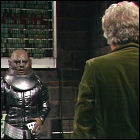 A battle-scarred Sontaran spaceship crashes in medieval England near the castle of Irongron, a plundering pirate who intends to overrun the nearby castle belonging to Sir Edward of Wessex. Linx, the Sontaran warrior, strikes an agreement with Irongron – Linx can repair his ship in Irongron’s castle, in exchange for giving him advanced weapons which are centuries ahead of the times. But Linx finds it impossible to conduct his repairs with nothing more advanced than Irongron’s forge, so he used what’s left of his ship’s technology to abduct scientists and materials from the 20th century. U.N.I.T. is called in to investigate, and the Brigadier isolates all of the remaining scientists who are likely to vanish in one securely guarded premise. But when another scientist disappears under the Doctor’s nose, he follows the trail to Irongron’s castle, where he finds himself up against the much more powerful and warlike Linx.
A battle-scarred Sontaran spaceship crashes in medieval England near the castle of Irongron, a plundering pirate who intends to overrun the nearby castle belonging to Sir Edward of Wessex. Linx, the Sontaran warrior, strikes an agreement with Irongron – Linx can repair his ship in Irongron’s castle, in exchange for giving him advanced weapons which are centuries ahead of the times. But Linx finds it impossible to conduct his repairs with nothing more advanced than Irongron’s forge, so he used what’s left of his ship’s technology to abduct scientists and materials from the 20th century. U.N.I.T. is called in to investigate, and the Brigadier isolates all of the remaining scientists who are likely to vanish in one securely guarded premise. But when another scientist disappears under the Doctor’s nose, he follows the trail to Irongron’s castle, where he finds himself up against the much more powerful and warlike Linx.
written by Robert Holmes
directed by Alan Bromly
music by Dudley SimpsonGuest Cast: Nicholas Courtney (Brigadier Lethbridge-Stewart), Kevin Lindsay (Linx), David Daker (Irongron), John J. Carney (Bloodaxe), Sheila Fay (Meg), Donald Pelmear (Professor Rubeish), June Brown (Lady Eleanor), Alan Rowe (Edward of Wessex), Gordon Pitt (Eric), Jeremy Bulloch (Hal), Steve Brunswick (Sentry), Jacqueline Stanbury (Mary)
Broadcast from December 15, 1973 through January 5, 1974
LogBook entry & review by Earl Green
Review: A largely light-hearted romp into the Middle Ages, The Time Warrior is a bit of a preview of Tom Baker’s era. In this story, the Doctor doesn’t seem terribly concerned with Irongron as a threat – he’s far more worried about the presence of Linx. But to give some credit where it is due, this story is probably  the best portrayal of a medieval setting in Doctor Who, with some excellent sets and costumes (though the knaves inhabiting these sets and costumes were far too clean-cut).
the best portrayal of a medieval setting in Doctor Who, with some excellent sets and costumes (though the knaves inhabiting these sets and costumes were far too clean-cut).
The Time Warrior also introduces us to Sarah Jane Smith, played by the always competent Elisabeth Sladen, though even her debut isn’t without its problems. The third Doctor has often been held up as an example of the Doctor as a very sexist character, with his assumption, in Terror Of The Autons, that Jo – then in her first episode – was the UNIT HQ tea lady. That somewhat ridiculous angle was played up again here, mainly to give Sarah a kind of pro-feminist platform speech. I have nothing against this, and indeed the introduction of a more independent female companion – especially after the constantly-weeping Jo Grant – was long overdue, but this first insight into Sarah’s character seemed a bit forced, and had no subtlety whatsoever. It could have caused a backlash against the character. But it was worth it to hear Sarah comment to Irongron’s serving wenches much later in the story that they were “still living in the Middle Ages”…as she realized that they were doing just that!
Linx, the first Sontaran we see in Doctor Who (they reappear in 1975’s The Sontaran Experiment, 1977’s The Invasion Of Time, and 1985’s The Two Doctors), is also the best of his kind. Later Sontaran characters just didn’t seem quite as invulnerable as Linx did, and even the standards of the frog-like Sontaran makeup seemed to decrease with each successive appearance. The Sontaran seen here was truly cool and very, very alien.
